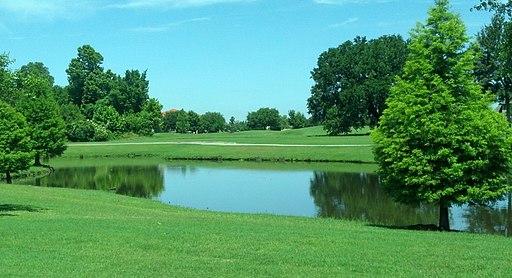Checking our recent rain gauge, it seems hard to believe the Earth’s water supply is finite. The fact remains, though, that while our planet holds 326,000,000 cubic miles of water, less than 1% of that amount is available as fresh water. Water is, without question, our most precious resource on this planet. It also plays an integral role in the ambiance of private ponds, lakes, HOA communities, shopping centers, golf courses, and other commercial and public properties.
Because water is so important for maintaining optimal conditions in various settings, it may seem that irrigation is the singular water-related concern for the property superintendent. There are, however, many other water-related issues to be considered, such as storm water, water quality, silt and sediments, and creek bank erosion. This article is part 1 of 2 that will address a common water-related concern, the control of algae and aquatic weeds in a property’s impoundments. Although unwanted aquatic growth may be seen primarily as an aesthetic nuisance, the impact of the problem and the treatment methods chosen can have far-reaching effects on the aquatic environment of a property. The water management methods that follow are intended not only to help superintendents enhance the property with which they are charged, but also to serve as practical suggestions for protecting our “thread of life” – water.
Identifying & Treating Aquatic Weeds
When a lake is filled with the aquatic weeds and or algae this condition is usually infamously referred to as “pond scum,”. The inclination is to seek a treatment that will provide immediate relief. One of the most common mistakes in the treatment of aquatic weeds is the misidentification of the target problem. Unfortunately, many aquatic weeds that are similar in appearance require radically different treatments. Too often, the wrong products are used, and they simply can’t get the job done- it’s like trying to treat a headache with Pepto-Bismol.
It is imperative to consult with a qualified specialist so the problem can be accurately identified, and an appropriate management strategy developed.
The goal of any aquatic treatment should be to apply the least amount of the correct product needed to do the job effectively. This approach saves money and puts less stress on environmental factors within the aquatic system. In some cases, it may not be necessary to use special equipment for aquatic applications; it can be as simple as adding a product directly from the container. Other products need direct contact with the target vegetation, which requires special equipment and/or application strategies for the best and safest results. Always consult and carefully follow label direction, as required by law, before making any aquatic applications.
In certain situations, it may be necessary to apply split treatments for algae or vegetation control to avoid fish kills. If an impoundment is choked with a submerged plant material such as Brazilian Elodea, for example, treating the entire problem at once is asking for trouble. Partial treatments would be advised, as excessive decaying vegetation would tie up the available dissolved oxygen in the water column and result in a fish kill. Because water becomes less able to retain dissolved oxygen as its temperature rises, water temperature is an important factor to consider as well, and summer applications should be carefully managed.
Effective, Environmentally-Friendly Weed Control
It is true that, in general, the most efficient short-term control method for unwanted aquatic growth is chemical treatment, but there are other management strategies available that are both environmentally friendly and effective. One increasingly popular option is the stocking of Triploid Grass Carp, or White Amur. Native to China, these fish were introduced as a vegetation management tool in the early 1970s. They are effective in controlling most, but not all, aquatic weeds.
With a lifespan of five to eight years, grass carp can be a cost-effective tool in an overall aquatic management control plan, but there are special characteristics of the fish to be taken into consideration. The fish will try to move downstream, so stocking rates must necessarily be high where containment is lacking. Because the feeding habits of the fish diminish over the lifespan, supplemental stock may be needed every two to three years. In addition, the fish can reach up to 30 pounds with age, limiting their ability to move into shallow areas and thereby diminishing their weed-control abilities. The majority of states have guidelines for the stocking of grass carp. In Georgia, for example, only sterile fish or Triploid can be stocked, and other regulations apply. Local regulatory authorities should be consulted before stocking any grass carp.
Enzyme products are a relatively new option for the control of unwanted aquatic plant growth and encouraging research has led to a good deal of interest in the method. Specifically formulated bacterial cultures designed to control algae, these enzymes monopolize the nutrients that feed the algae, essentially “starving” the algae. It should be noted that enzyme products work best in situations where supplemental aeration is provided through surface or subsurface aerations units. Also, enzymes must be added to an impoundment on a regular basis to be effective, and their usefulness is somewhat limited where there is a good deal of water flow, as they are easily flushed out. Because they are sensitive to water temperature, enzyme products are ineffective during the dormant season. While clearly not a cure-all, enzymes do seem to provide a reasonable level of chemical-free control when used utilized properly.
In our upcoming article Part II of Protecting Water Quality, we will focus on water quality management options that can be utilized to enhance water quality by the installation of various types of aeration systems in lakes and ponds.



